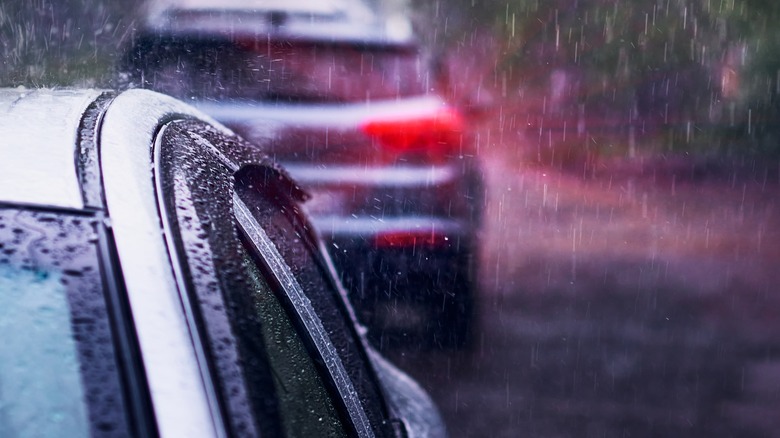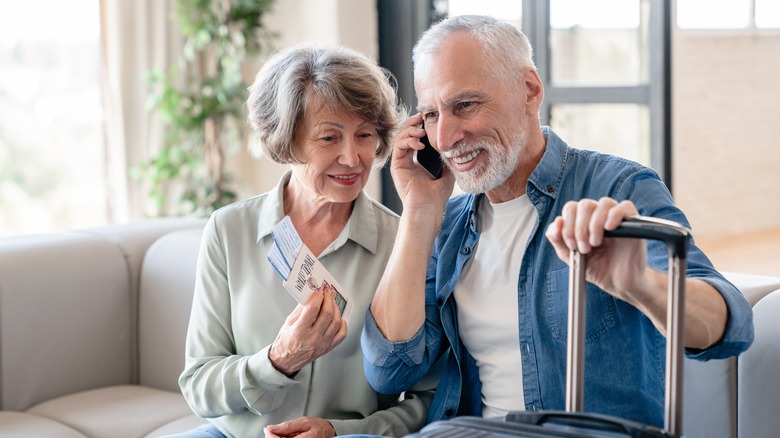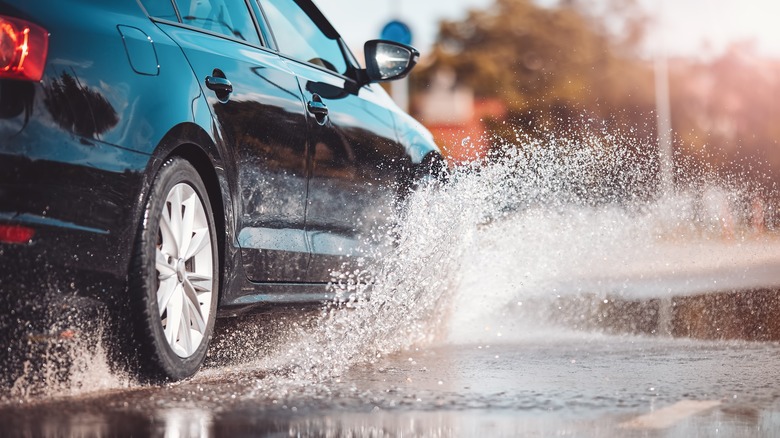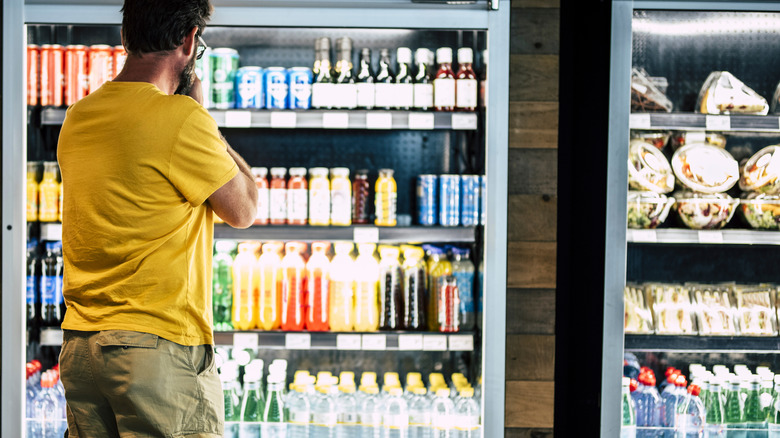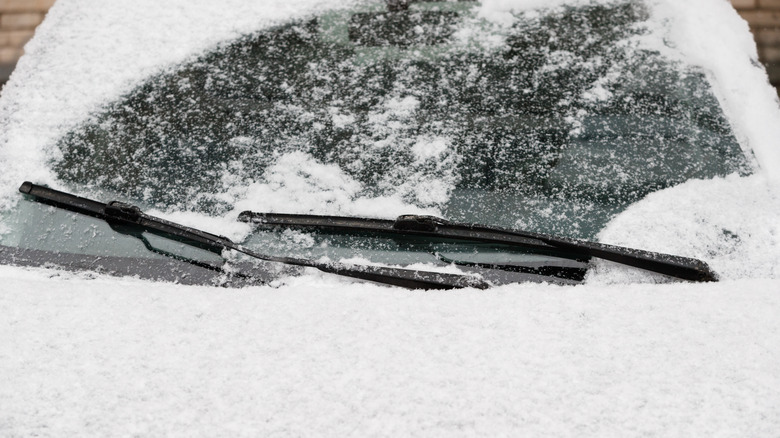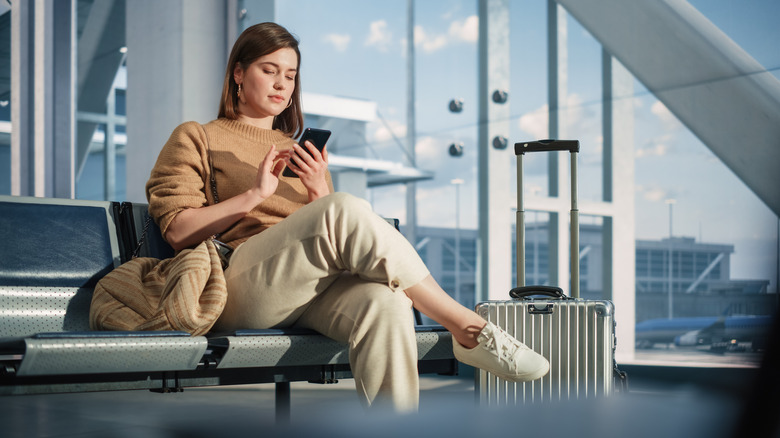Travel Experts Like Samantha Brown Share Their Top Tips For Traveling Through Storms Safely
Diligent pre-planning can help you avoid traveling through storms. Before making trip reservations, it's wise to research weather patterns in your destination. For example, summer (November to April) is arguably the worst time of the year to visit Fiji, as there's typically more rainfall. Regardless of the location, travelers should refrain from driving if there's an incoming storm. Yet, making your way through harsh conditions can be unavoidable sometimes. Whether you're flying out of your destination or taking a road trip, it's necessary to understand how to navigate a storm safely.
While there's an overlap between safely driving and flying amid a storm, transportation preparation is distinct in various ways. Additionally, you'll need to plan for the type of storm you'll face. As far as driving, AAA Mid-Atlantic manager Jana L. Tidwell explained (via AAA Club Alliance), "A vehicle can either be very dangerous or a place of safety, depending on the weather conditions." With freezing temperatures and icy precipitation, winter storms bring unique issues.
It's a bit of a different story if your flight is affected by an incoming storm. Samantha Brown, Travel Channel host, and seasoned globetrotter took to her website to share her expertise on this topic. According to her, travelers should have multiple plans to avoid getting stranded at the airport. Brown, as well as other travel experts, have highlighted top tips for traveling through storms safely.
Book flight and hotel arrangements as soon as possible
So, how should you proceed if you reach your destination and the forecast predicts an incoming storm? Talking to The New York Times, natural disaster safety expert Tim Horner advised travelers to take immediate action. He explained, "Your first line of defense should be to evacuate if you can and follow the evacuation directions of the local authorities." According to Horner, fliers should book a ticket for the next available flight. If possible, departing days ahead of the big storm is the best course of action.
If your flight is scheduled close to the incoming storm, securing backup accommodations is wise. Samantha Brown suggested booking a hotel near or in the airport on her website. "At the very least have the nearby hotel numbers ready to go so you can call immediately if you need to. And be sure to note their local number, not the 800 number," she wrote. In the event of a flight delay, you'll be much more comfortable relaxing at a hotel than camping at the airport.
Best practices for road safety
Emergency road kits will help drivers stay safe during storms. According to CBS News, AAA spokesperson Ragina Ali recommends bringing essentials such as a shovel, an ice scraper, jumper cables, a blanket, warm clothes, and accessories for wintry conditions. Ali identified sand, salt, and kitty litter as solutions for stuck tires. According to the National Weather Service, an emergency road kit should also include a flashlight, cell phone charger, first aid kit, tow rope, tire chains, flares, water, and snacks.
Of course, careful driving is crucial when steering through storms. Whether it's raining or snowing, drivers should reduce their speed. AAA spokesperson John Treanor told ABC30, "Increase the distance between you and the car in front of you in case they brake suddenly, you don't have to jam on your brakes." If there's a torrential downpour, slamming on the brakes could lead to hydroplaning. What should you do if you lose control and start veering off course? Treanor advised drivers to stay calm. "When you panic, your first instinct is 'I'm moving where I don't want to be I need to slam on the brake.' That can make it a worse situation. You want to keep steering in the direction you want your car to go."
Always carry basic necessities
Storms can unexpectedly change travel plans, from flight delays to power outages. On her website, Samantha Brown outlines the necessary preparations for such diversions. While bringing snacks on your travels is never a bad idea, self-sufficiency is paramount if a storm is expected. Brown encourages travelers to keep water and food items on hand wherever they are.
Aside from trail mix and granola bars, Brown recommends bringing peanut butter, her go-to snack. In an interview with journalist Julie Loffredi, she shared, "It's my survival food. You can always find things that go with peanut butter. If you're really desperate, you can just stick your whole finger in a jar of peanut butter." Brown is a fan of individual packets, as full peanut butter jars are not TSA-approved for carry-ons.
Before the storm hits, Brown advises travelers to withdraw sufficient cash from the ATM. Fliers should also pack toiletries, undergarments, extra clothes, and medications into their carry-on bag. For additional protection, consider organizing your carry-on belongings in Ziploc bags. All in all, having immediate access to basic necessities is imperative.
Vehicle precautions for winter storms
Drivers who plan to brave winter storms should take precautions to ensure their vehicle is in excellent condition. Talking to CBS News, AAA spokesperson Ragina Ali noted the importance of inspections. To avoid malfunctions, check essential parts like the battery and tires. Ali said don't neglect windshield wipers either, as blades need strength to handle precipitation. They added, "But you also want to make sure that you have windshield wiper fluid, particularly some that have a mixture that won't freeze."
Emergency expert Eric Stern and AAA repair systems manager David Bennett told NPR that drivers should fill their gas tanks before winter road trips. Stern cited hypothermia as a major concern of these seasonal storms. Sufficient fuel can provide vital warmth if drivers are stuck in lengthy road delays. According to BBC, National Weather Service coordinator Michael Muccilli advised drivers to run their motor in 10-minute intervals with the window ajar. According to him, this method will supply heat without wasting much gas.
Use these efficient technology solutions
Samantha Brown (via her website) suggests following airlines on social media to stay up to speed on weather advisories. She writes, "I can't stress enough how important it is when you travel to have either Instagram, Threads, or X (formerly Twitter) for updates and alerts as well as getting answers to your direct questions." Reaching out on such platforms could be more efficient than calling, as Brown mentioned that many airlines now utilize social media to provide customer support.
In the event of a last-minute flight cancellation, the re-booking process may be quicker online. Brown recommends GetHuman, a website that offers representative numbers and contact details for major companies for phone call shortcuts. Thanks to modern-day technology, there is a wealth of great apps for making your travel plans.
Speaking of technology, keeping your cell phone charged when traveling is crucial. Per The New York Times, safety expert Tim Horner urged travelers to carry portable chargers or power packs. As long as these devices are already charged, you won't have to search for wall outlets when your phone battery is low.
